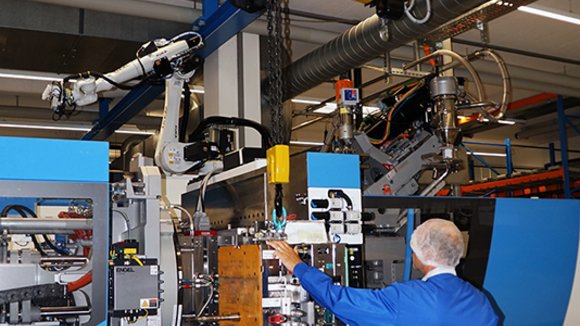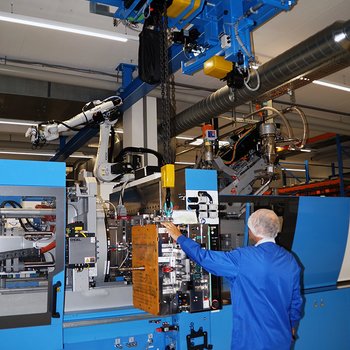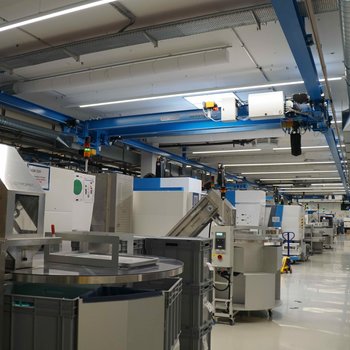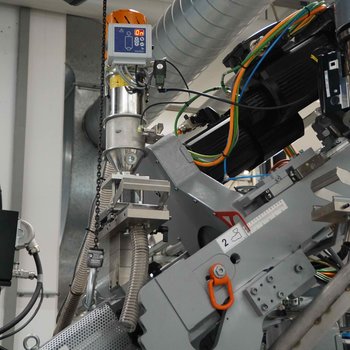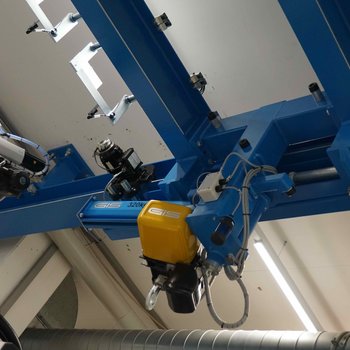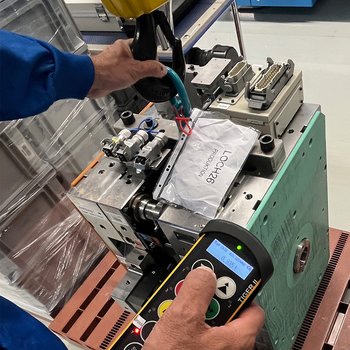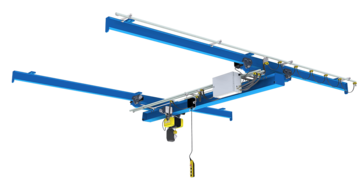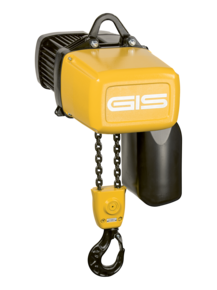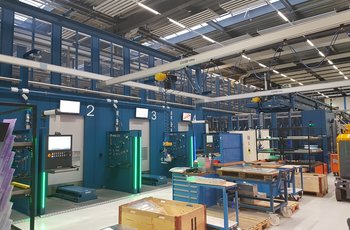Translation of the german version:
Ypsomed is the leading developer and manufacturer of injection and infusion systems for self-medication. As a proven diabetes specialist, it has more than 35 years of experience. The headquarters of the family-owned company is in Burgdorf. In addition to development and toolmaking, an important production site for medical technology is also located here. Pharmaceutical companies make up the worldwide customer base.
Demand is growing continuously and requires an expansion of the production infrastructure for plastic parts. Thus, the existing machinery is to be supplemented with further injection moulding machines and an existing indoor crane system is to be replaced by a new one. In the future, it will transport heavy injection moulding tools and enable easy machine maintenance. All movements must now be electrically driven and safely controllable by radio remote control.
Close cooperation enables optimal solution
Ypsomed has a long-standing partnership with the crane manufacturer GIS. At the two production sites in Burgdorf and Solothurn, systems from the Swiss manufacturer have been proving themselves in tough practical use for years. This new project is also to be realised jointly. Already at the beginning of the planning phase, GIS AG has to incorporate the customer's specifications in an initial concept design. The high market dynamics require several adjustments to the planning. Subsequently, the existing concept is further developed together and continuously refined. The solution provides for two travelling cranes to handle the sensitive tools and two lateral slewing cranes to serve the space between the columns for machine maintenance.
Safe handling
The safety concept is based on a precise analysis of possible hazardous situations. For example, a travelling crane can only be moved in high speed under certain conditions: Slewing crane swivelled in locked, large chain hoist parked in the aisle and load hook raised to end position. All parking positions are checked via limit and star switches. For static reasons, the two overhead travelling cranes are allowed to approach each other at a minimum distance of five metres. Light barriers constantly monitor the distance. If there is a risk of the distance being undershot, the speed is reduced. If necessary, the overhead travelling crane is stopped.
Limited space conditions
Handling robots tower above the closely positioned injection moulding machines, which take over the finished plastic parts and place them in containers with lightning-fast movements. The longitudinal girders of the crane system, which run between columns, are suspended from the hall ceiling by means of brackets. Two double-girder underslung travelling cranes with modern GIS electric chain hoists have a load capacity of 3200kg each. They transport injection moulds weighing up to 2500kg. The two front-mounted slewing cranes facilitate the maintenance of machine parts that are difficult to access. In parking position and with the load hook retracted, they move around the handling robots. Everything happens in a confined space, with only a few centimetres distance to obstacles.
Gently transported and precisely positioned
All drives have two infinitely programmable speeds. Frequency inverters ensure smooth, low-vibration movement of the load. All three axes are equipped with creep speed for this purpose. Precise and gentle positioning is essential during mould changes. The injection moulding tool can be "preloaded" with its own weight for removal from the machine, so that no unintentional lowering or lifting occurs when the connecting screws are loosened. This is made possible by the constantly updated weight display on the radio remote control. The load measuring pin of the hoist records the data for this in real time. For the installation of the new tool, the sensitive load can be positioned precisely in the machine.
Maintenance work made easier
Plastic injection moulding machines have a plasticising unit located laterally in front of the mould, which has to be maintained periodically. For space reasons, however, these areas are located between the building columns where they cannot be reached by the main crane. A small column-mounted slewing crane with electric chain hoist is attached to the corresponding end of each of the double girders. To prevent collisions, it can be locked in a swivelled position.
Realisation without rework
During the conversion project, production is to be only minimally restricted. For this purpose, the hall will be divided into two halves and separated dust-tight. In one, production can continue with the existing infrastructure. In the other, specialists from Schötz will dismantle the old hall crane one after the other, drill into the ceiling consoles, assemble part of the new crane system and put it into operation. Then a change of sides takes place. The loss of production is minimised with this procedure. The teamwork between Ypsomed and GIS, from planning to completion of the modern crane system in a dynamic environment, works flawlessly. Commissioning takes place on time and without the need for further adjustments. A GIS maintenance contract ensures the reliable functioning of the modern crane system.
Author: Arthur Kemény, CH-5363 Weggis
Technical data / fact sheet
- This crane system consists of a special construction of two double girder underslung travelling cranes, with intermediate structure and side-mounted slewing crane. The load capacity of one travelling crane is 3200kg and that of the slewing crane 320kg. All drives are frequency-controlled with soft start.
- The cranes serve an area of around 52m long and 6m wide. All components such as profiles and suspensions come from GIS.
- Two crane runway sections HEA 220, each 51.8m long, are attached to 22 suspensions of different lengths.The IPE 270 crane girder sections have a span of 5.8m.
- The double girder bridge with modern double fall electric chain hoist, type GPOD1600, makes optimal use of the low hall height. This results in an available lifting height of 3.3m. The two frequency-controlled lifting speeds are continuously programmable (0.6-3.5m/min). The control is located in a switch box on the crane girder.
- Load measuring pins in the electric chain hoists record the nominal load and transmit it to the radio remote control for display on the screen.
- All motorised trolleys of the type GMFO are frequency-controlled. The two travel speeds can be programmed continuously (crane travel 6-30m/min and cross travel 3.6-20m/min).
- A collision safety device by means of a light barrier prevents the permissible minimum distance between the travelling cranes (hook spacing > 5000mm) from being undershot.
- Two slewing cranes, each attached to the end of a travelling crane, have the following data: GIS electric chain hoist GPOD250, S.W.L. 320kg, outreach 975mm, mechanical locking of the jib in retracted rest position 95° and electrical monitoring.
- The system is operated by one radio remote control per overhead travelling crane, with the functions: Up/down (chain hoist 1), left/right, forward/back, up/down (chain hoist 2), horn and emergency control switch. The display shows the current lifting weight of chain hoist 1 in real time.
- The electrical supply 3x400V, 50Hz, takes place in longitudinal direction via a conductor rail and in transverse direction via energy chain.
